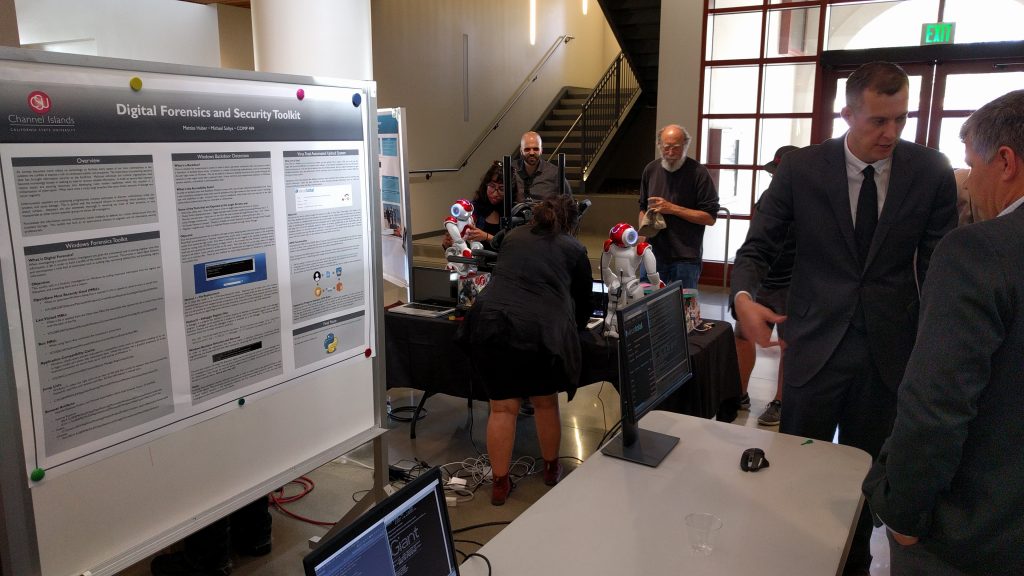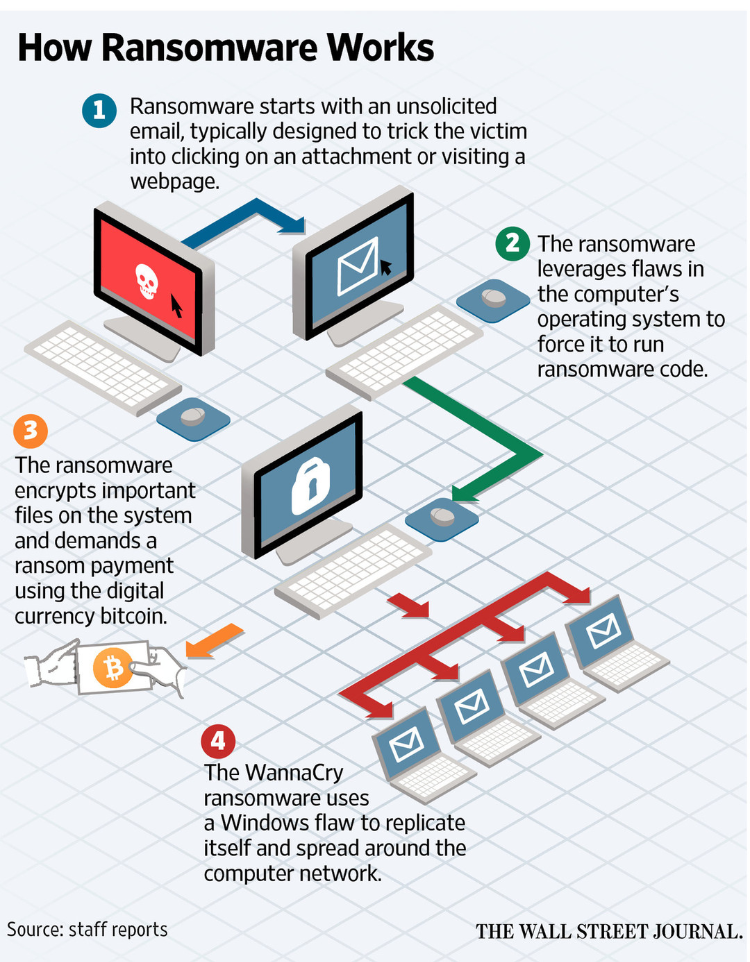For the last 30 years, C has been my programming language of choice. As you probably know, C was invented in the early 1970s by Dennis M. Ritchie for the first UNIX kernel and ran on a DEC PDP-11 computer. I am probably a bit old-fashioned. Yes, C is outdated, but I’m simply addicted to it, like plenty of other embedded system programmers. For me, C is a low level but portable language that’s adequate for all my professional and personal projects ranging from optimized code on microcontrollers to signal processing or even PC software. I know that there are many powerful alternatives like Java and C++, but, well, I’m used to C.
C is not the only vintage programming language, and playing with some others is definitively fun. This month, I’ll present several vintage languages and show you that each language has its pros and cons. Maybe you’ll find one of them helpful for a future project? I’m sure you won’t use COBOL in your next device, but what about FORTH or LISP? As you’ll see, thanks to web-based compilers and simulators, playing with programming languages is simple. And after you’re finished with this review of 1970s-era computing technology, give one or two a try!
BASIC
Like many teenagers in the 1970s, I learned to program with Beginner’s All-purpose Symbolic Instruction Code (BASIC). In 1980, after some early tests with programming calculators, a friend let me try a Rockwell AIM-65 computer. An expanded version of the KIM-1, it had an impressive 1 KB of RAM and a BASIC interpreter in ROM. It was my first contact with a high-level programming language. I was really astonished. This computer seemed to understand me! “Print 1+1.” “Ok, that’s 2.” One year later, I bought my first computer, an Apple II. It came with a much more powerful BASIC interpreter in ROM, AppleSoft Basic. (This interpreter was developed for Apple by a small company named Microsoft, but that’s another story.)
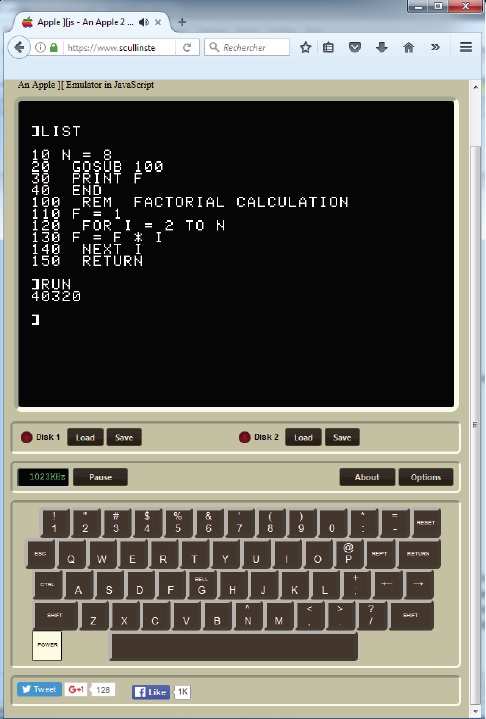
PHOTO 1: An online emulator for my old Apple II
Now let’s launch an Apple II emulator and write some software for it. Look at Photo 1. Nice, isn’t it? This pretty emulator, developed in JavaScript by Will Scullin, is available online. Just launch it, enter this 10-line program, and then type “RUN”. It will calculate for you the factorial of eight: 8! = 1 × 2 × 3 × 4 × 5 × 6 × 7 × 8, which is 40,320.
Since its invention in 1964 at Dartmouth College, BASIC is more of a concept than a well-specified language. Plenty of variants exist up to Microsoft’s Visual Basic. But it has plenty of disadvantages, especially its early versions: a lack of structured data and controls, mandatory line numbering, a lack of type checking, low speed, and so on. Nevertheless, it is ultra-simple to learn and to understand. Even if you have never used BASIC, you’ll understand the code shown in Photo 1 without any problem. The main program starts by initializing a variable N with the value 8. I then calls a subprogram that starts at line 100, displays the result F, and stops. The subprogram initializes F to 1 and multiplies the result by each integer up to N. Straightforward.
C LANGUAGE
Let compare this BASIC with a C version of the same algorithm. For this article, I looked for online compilers and simulators. I found a great option at www.ideone.com, which, developed by Sphere Research Labs, supports more than 60 programming languages. You can edit a program using any of them, compile it, and test it without having to install anything on your PC. This is great for experimenting.

PHOTO 2: At Ideone.com, you can enter, compile, and simulate numerous programming languages. Here you see C language.
The C variant of the factorial algorithm is depicted in Photo 2. I could have used plenty of different approaches, but I tried to stay as close as possible to the “spirit” of C. So, how does it compare with BASIC? The code is significantly more structured, but a little harder to read. C aficionados loves short forms like f*=i++ (which multiplies f by i and then increments i) even when they can be avoided. While this makes the code shorter and helps the compiler with optimization, it is probably cryptic to someone new to the language.
Of course, C also has great strengths. In particular, it offers you precise control of the data types and memory representation, which helps for low level programming. That’s probably why it has been so widely for nearly 50 years.
FORTRAN & COBOL
Let’s stay in the 1970s. BASIC or assembly language was for hobbyists and experimenters. C was used by early UNIX programmers. The rest of the programming world was divided into two camps. Scientifics used FORTRAN. Business leaders used COBOL.
FORTRAN (from FORmula TRANslation) was actually the first high-level programming language. Developed by an IBM team led by John Backus, the first version of FORTRAN was released in 1957 for the IBM 704 computer. It was followed by several incremental improvements: Fortran 66 (1966), Fortran 77, and Fortran 90, all the way up to Fortran 2008. Refer to Listing 1 for the factorial program using FORTRAN 77.
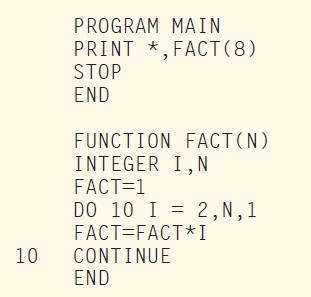
LISTING 1: This is the factorial program using FORTRAN 77.
It seems close to BASIC, right? That’s not a surprise as BASIC was in fact based on concepts from FORTRAN and from another disapeared language, ALGOL. I’m sure that you are able to read and understand the FORTRAN in Listing 1, but its equivalent in COBOL is a bit stranger (see Listing 2). I must admit that it took me some time to make it working, even after reading some COBOL tutorials on the web. COBOL is an acronym for Common Business-Oriented Language, so it is not exactly targeting an application like a factorial calculation. It was developed in 1959 by a consortium named CODASYL, based on works from Grace Hopper. Even though its popularity fading, COBOL is still alive. I even read that an object-oriented version was released in 2002 (COBOL 2002) and even upgraded in 2014.
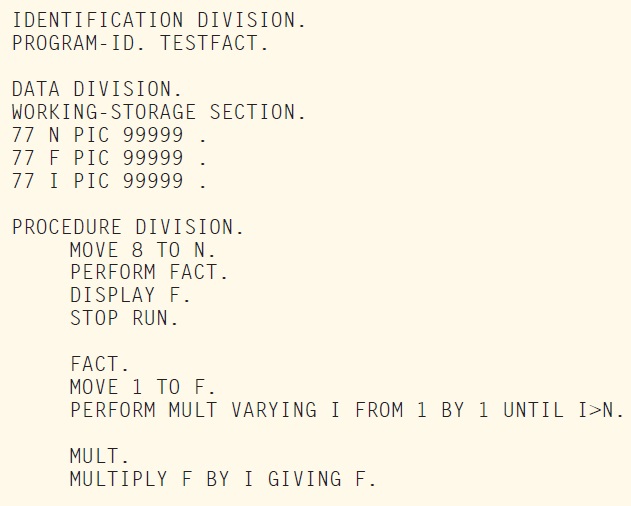
LISTING 2: The COBOL version looks a little stranger, right?
PASCAL & FRIENDS
I never actually used FORTRAN or COBOL, but I developed software on my Apple II using PASCAL. Released in 1970 by Niklaus Wirth (ETH Zurich, Swizerland), PASCAL was probably one of the earliest efforts to encourage structured and typed programming. Based on ALGOL-W (also invented by Wirth), it was followed by MODULA-2 and OBERON, which were less known but still influential.
Do you want to calculate a factorial in PASCAL? Here it is Listing 3. It may look familiar to FORTRAN or BASIC, but its advantages are in the details. PASCAL is a so-called strongly typed language. (You can’t add a tomato and a donut, contrarily to C.) It also forbids unstructured programming and it is very easy to read. PASCAL was a limited, but true, success. It was used in particular by Apple for the development of the Lisa computer as well as the first versions of the Macintosh. It is still in use today through one of its object-oriented versions, DELPHI.
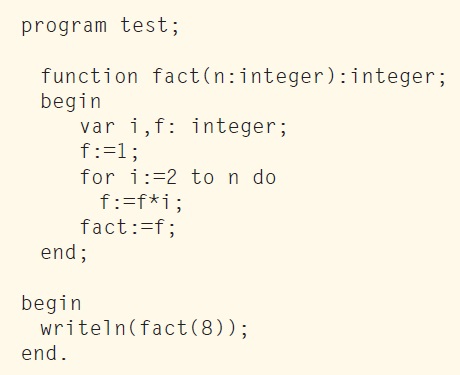
LISTING 3: This is the PASCAL version. Easy to read.
THE ADA STORY
In the 1970s, the United States Department of Defense (DoD) conducted a survey and found that they were using no less than 450 different programming languages. So, it decided to define and develop yet another one—that is, a new language to replace all of them. After long specification and selection phases, a proposal from Jean Ichbiah (CII Honeywell Bull, France) was selected. The result was ADA. The name ADA, and its military standard reference (MIL-STD-1815), are in memory of Augusta Ada, Countess of Lovelace (1815–1852), who created of the first actual algorithms intended for a machine.
While ADA is, well, strongly typed and very powerful, it’s complex and quite boring to use (see Listing 4). The key advantage of ADA is that it is well standardized and supports constructs like concurrency. Thanks to its very formal syntax and type checking, it is nearly bug-proof. Based on my minimal experience, it is so strict that the first version of the code usually works, at least after you correct hundreds of compilation errors. That’s probably why it is still largely used for critical applications ranging from airplanes to military systems, even if it failed as a generic language.
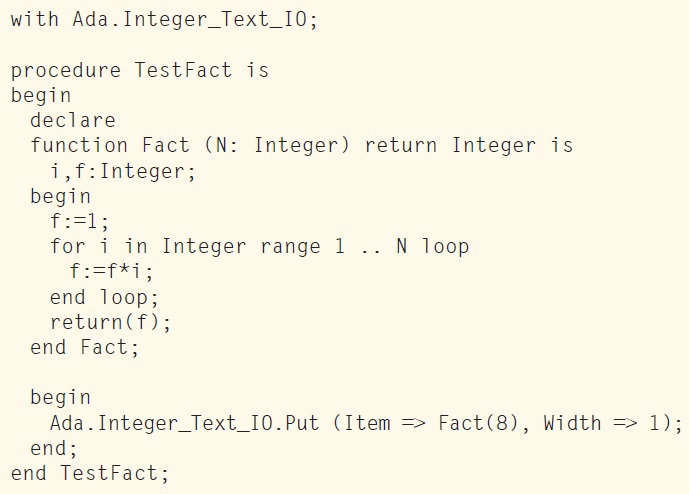
LISTING 4: ADA is more verbose.
LISP & FORTH
ADA is a difficult language. In my opinion, LISP (List Processing) is far more interesting. It is an old story too. Designed in 1960 by John McCarthy (Stanford University), its concepts are still interesting to learn. McCarthy’s goal was to develop a simple language with full capabilities. That’s quite the opposite of ADA. The result was LISP. The syntax can be frightening, but you must try it. Listing 5 is a version of the factorial calculation in LISP.
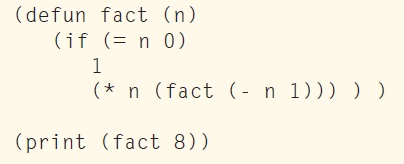
LISTING 5: LISP is definitively fun!
In LISP, everything is a list, and a list is enclosed between parentheses. To execute a function, you have to create a list with a pointer to the function as a first element and then the parameters. For example, (- n 1) is a list that calculates n – 1. (if A B C) is a structure which evaluates A, and then evaluates either B or C based on the value of A. If you read this program, you will see that it is not based on a loop like all other versions I’ve presented, but on a concept called recursion. A factorial of a number is calculated as 1 if the number is 0, and as N times the factorial of (N – 1) otherwise. LISP was in fact the first language to support recursion—meaning, the possibility for a function to call itself again and again. It is also the first language to manage storage automatically, using garbage collection. Even more interesting, in LISP everything is a list, even a program. So in LISP, it is possible to develop a program that generates a program and executes it!
Another of my favorites is FORTH. Designed by Charles Moore in 1968, FORTH also supports self-modifying programs like LISP, and it is probably even more minimalist. FORTH is based on the concept of a stack, and operators push and pop data from this stack. It uses a postfix syntax, also named Reversed Polish Notation, like vintage Hewlett-Packard calculators. For example, 1 2 + . means “push 1 on the stack,” “push 2 on the stack,” “get two figures from the stack, add them and put the result back on the stack,” and “get a figure from the stack and display it.”
Here is our factorial program in FORTH:
: fact dup 1 do I * loop ; 8 fact .
The first line defines a new function named fact, and the second line executes it after pushing the value 8 on the stack. The syntax is of course a bit strange due to the postfixing but it is clear after a while. Let’s start with 8 on the stack. The command dup duplicates the top of the stack. The do…loop structure gets count and first index from the stack so it executes I * with I varying from 1 to 7, and each iteration multiplies the top of the stack by the index I. That’s it. You can try it using another web-based programming and simulation host: https://repl.it. Look at the result in Photo 3.
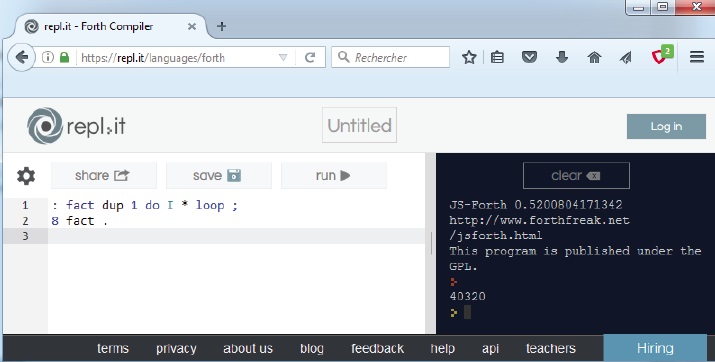
PHOTO 3: This is an example of FORTH in the Repl.it online compiler and simulator.
FUN WITH PROLOG & APL
LISP and FORTH are fun, but PROLOG is stranger. Developed by Alain Colmerauer and his team in 1972, PROLOG is the first of the so-called declarative languages. Rather than specifying an algorithm, such a declarative language defines facts and rules. It then lets the system determine if another fact can be deduced from them. An example is welcome.

LISTING 6: The PROLOG version based on a completely different paradigm.
Listing 6 is our factorial in PROLOG. The first fact states that the factorial of any number lower than 2 is 1. The second fact states that the factorial of any number X is F only if F is the product of X and another number, named here FM1, and if FM1 is the factorial of X – 1. This looks like a recursion, and this is recursion, but expressed differently. Then the last line states that X is the factorial of 8 and ask PROLOG to display X, and you will have the result. This is a confusing approach, but it is close to the needs of artificial intelligence algorithms.
Lastly, I can’t resist to the pleasure to show you another exotic vintage programming language, A Programming Language (APL). Refer to the factorial example in APL in Photo 4. I can’t even write it in the text of this article because APL uses nonstandard characters.
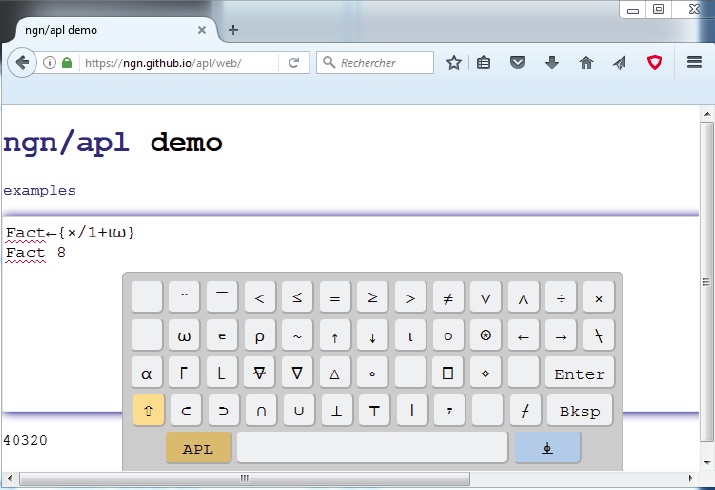
PHOTO 4: APL looks great, right? It’s unique keyboard alone is fun!
In fact, APL-enabled computers had APL-specific keyboards! Published in 1962 by Kenneth Iverson (Harvard University and then IBM), it was firstly a mathematical notation and then a programming language. Based largely on data arrays, APL targets numerical calculations so it isn’t a surprise to see that our factorial example is so compact in this language. Let’s understand it by reading the first line from right to left. The omega Greek symbol is the parameter of the function (that is, 8 in this case). The small symbol just before the omega called “iota” is generating a vector from 0 to N – 1, so here it is generating 0 1 2 3 4 5 6 7. The 1+ is adding one to each element of the array. This gives 1 2 3 4 5 6 7 8. Lastly, the x/ asks to multiply each value of the vector, which is the factorial!
GET STARTED
After finishing this article, I searched the web for other interesting languages and found, well, a more than impressive website. Launch your browser right now and enter http://rosettacode.org. These crazy guys simply listed 837 programming tasks, and let the community program each of them with all programming languages. Yes, all of them, and no less than 648 different languages are referenced! Of course, I searched for a factorial calculation algorithm and found it. Versions of the factorial code for 220 different languages are provided! So, you can find similar versions to the ones I provided in this article as versions for more recent languages (Java, Python, Perl, etc.). You will also find obscure languages.
My goal with this article was to show you that languages other than C and JAVA can be fun and even helpful for specific projects. Vintage languages are not dead. For example, it seems that FORTH was used for NASA’s Rosetta mission. Moreover, innovation in computing languages goes on, and new and exciting alternatives are proposed every month!
Don’t hesitate to play with and test programming languages. The web is an invaluable tool for discovering new tools, so have fun!
This article appears in Circuit Cellar 323.
 Robert Lacoste lives in France, between Paris and Versailles. He has 30 years of experience in RF systems, analog designs, and high speed electronics. Robert has won prizes in more than 15 international design contests. In 2003 he started a consulting company, ALCIOM, to share his passion for innovative mixed-signal designs. Robert’s bimonthly Darker Side column has been published in Circuit cellar since 2007.
Robert Lacoste lives in France, between Paris and Versailles. He has 30 years of experience in RF systems, analog designs, and high speed electronics. Robert has won prizes in more than 15 international design contests. In 2003 he started a consulting company, ALCIOM, to share his passion for innovative mixed-signal designs. Robert’s bimonthly Darker Side column has been published in Circuit cellar since 2007.
Source: Vintage Programming Languages | Circuit Cellar
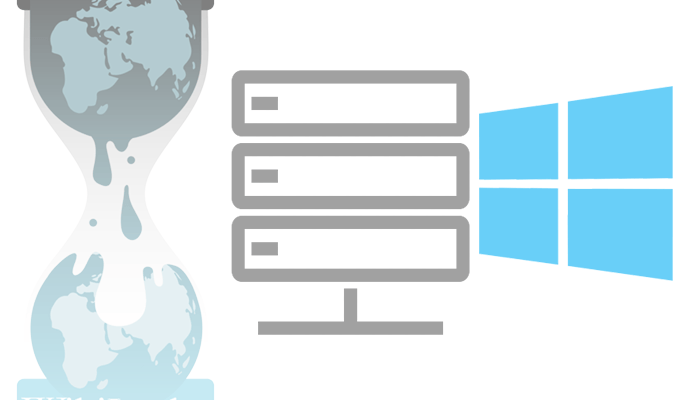
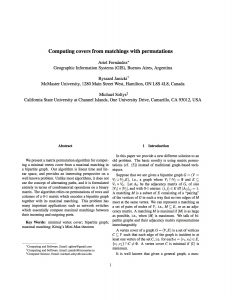











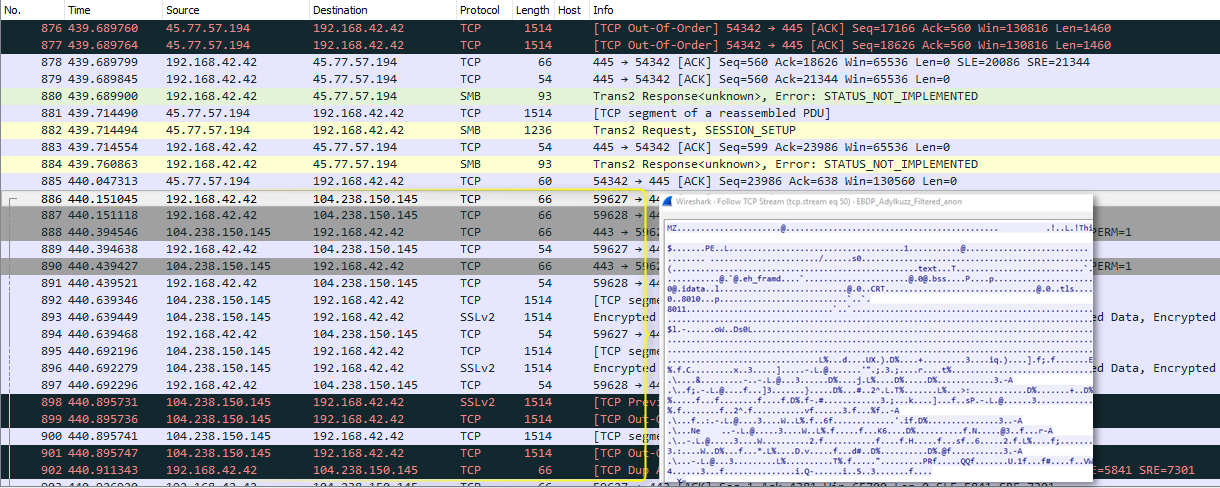 On Friday, May 12, attackers spread a massive ransomware attack worldwide using the EternalBlue exploit to rapidly propagate the malware over corporate LANs and wireless networks. EternalBlue, originally exposed on April 14 as part of the Shadow Brokers dump of NSA hacking tools, leverages a vulnerability (MS17-010) in Microsoft Server Message Block (SMB) on TCP port 445 to discover vulnerable computers on a network and laterally spread malicious payloads of the attacker’s choice. This particular attack also appeared to use an NSA backdoor called DoublePulsar to actually install the ransomware known as WannaCry.
On Friday, May 12, attackers spread a massive ransomware attack worldwide using the EternalBlue exploit to rapidly propagate the malware over corporate LANs and wireless networks. EternalBlue, originally exposed on April 14 as part of the Shadow Brokers dump of NSA hacking tools, leverages a vulnerability (MS17-010) in Microsoft Server Message Block (SMB) on TCP port 445 to discover vulnerable computers on a network and laterally spread malicious payloads of the attacker’s choice. This particular attack also appeared to use an NSA backdoor called DoublePulsar to actually install the ransomware known as WannaCry.

